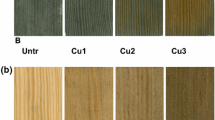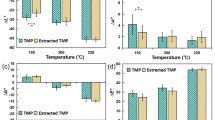Abstract
Studies were made with pentachlorophenol (PCP) to determine the effects of temperature, air flow, humidity, carrier solvents, and wood coating systems on the vaporization properties of PCP. Temperature had the greatest effect on PCP vaporization from treated wood. Methylene chloride was associated with the highest air concentrations of PCP. The cosolvent WC-144 was most effective in reducing PCP vaporization, and a bituminous coating and an epoxy paint were the most effective coatings for reducing PCP vaporization from treated wood.
Similar content being viewed by others
References
Department of Agriculture (USA) (1980) Biological and economic assessment of pentachlorophenol, inorganic arsenicals and creosote. Techn Bull 1658-1, Washington, DC
Gebefugi I, Porlar H, Korte F (1979) Occurrence of pentachlorophenol in enclosed environments. Ecotoxicol and Environ Safety 3:269–300
Ingram LL Jr, McGinnis GD, Gjovik LR (1981a) The relative amount of pentachlorophenol volatilization from treated wood. Proc Am Wood-Preservers' Assoc 77:102–108
Ingram LL Jr, McGinnis GD, Jasperse G, Gjovik LR (1981b) The effects of solvent systems on the volatilization of pentachlorophenol from treated wood. Proc Am Wood-Preservers' Assoc 77:109–117
Ingram LL Jr, McGinnis GD, Pope PM, Gjovik LR (1983) The effect of coating systems on the vaporization of pentachlo-rophenol from treated wood. Proc Am Wood-Preservers' Assoc 79
Ingram LL Jr, McGinnis GD, Parikh SM (1979) Determination of pentachlorophenol in water by mass spectrometric isotope dilution. Anal Chem 51:1077–1079
Saur JM, Walcheski PJ, Nicholas DD, Gjovik LR (1982) The concentration of airborne pentachlorophenol within treated wood structures. Proc Am Wood-Preservers' Assoc 78:169–173
Warren JS, Lamparski LL, Johnson RL, Gooch RM (1982) Determination of pentachlorophenol volatilization from wood by collection on silica gel. Bull Env Contam Toxicol 29:719–726
Whitney RW, Gearhart HL (1979) Airborne pentachlorophenol concentrations within treated structures, Report submitted to Southern Regional Pesticide Impact Assessment State Liaison Coordinators. Oklahoma State University, Stillwater, OK
Wylie JA, Gabica J, Benson WW, Yoder J (1975) Exposure and contamination of air and employees of a pentachlorophenol plant, Idaho-1972. Pestic Monit J 9:150–153
Author information
Authors and Affiliations
Additional information
Some of the data in this report are reproduced with the kind permission of the American Wood-Preservers' Association (AWPA), Stevensvilie, Maryland 21666.
The use of trade names does not constitute an endorsement of those products by the authors or this laboratory.
Rights and permissions
About this article
Cite this article
Ingram, L.L., McGinnis, G.D. & Gjovik, L.R. Studies on the vaporization of pentachlorophenol from treated wood. Arch. Environ. Contam. Toxicol. 15, 669–676 (1986). https://doi.org/10.1007/BF01054914
Received:
Revised:
Issue Date:
DOI: https://doi.org/10.1007/BF01054914




